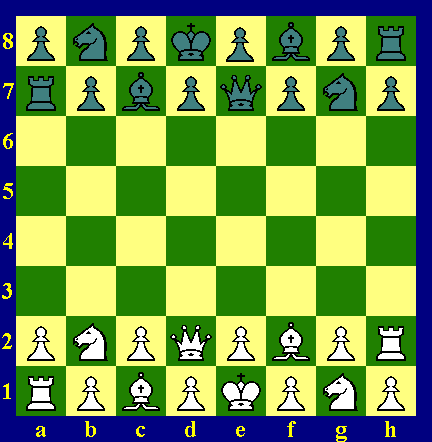Paloma Chess
By Becca Rabong
Introduction
Paloma Chess is named after Paloma Quintanilla, the latest addition to the Quintanilla family, a daughter born on February 4th, 2005. The variant, invented by a Notre Dame student, is characterized by a royal queen. The Queen, then, is both the most powerful and important piece on the board in this variant.Board
The game uses the standard 8X8, 64-cell board.Setup
The opening array is as follows: White has Pawns at a2, b1, c2, d1, e2, f1, g2, and h1, Rooks at a1 and h2, Knights at b2 and g1, Bishops at c1 and f2, a Royal Queen at d2, and a non-royal King at e1.Black has Pawns at a8, b7, c8, d7, e8, f7, g8, and h7, Rooks at a7 and h8, Knights at b8 and g7, Bishops at c7 and f8, a Royal Queen at e7, and a non-royal King at d8.

Pieces
Standard FIDE chess pieces are used in this game. Pieces possess their regular moves. However, the Queen is royal and the King is not.Rules
A player wins by mating his opponent's Queen. Since Queens are royal, they may not enter, or pass through an attacked square, except when a player has two Queens (see below).Pawns promote to Rook, Bishop, or Knight. They still have an initial double move, but there is no en-passant capture.
The King promotes to a Royal Queen upon reaching the far rank (same as where Pawns promote). If a player promotes his King, then as long as he has two royal Queens on the board, they are not subject to check, only capture, and thus may enter or pass through attacked squares. If a Queen is captured, then the remaining Queen is once again subject to check.
Castling is not permitted.
Equipment
A standard chess set is used to play this variant.
Designed by Becca Rabong
Written by Becca Rabong and Paul DeWitte
WWW page created: February 11th, 2005
